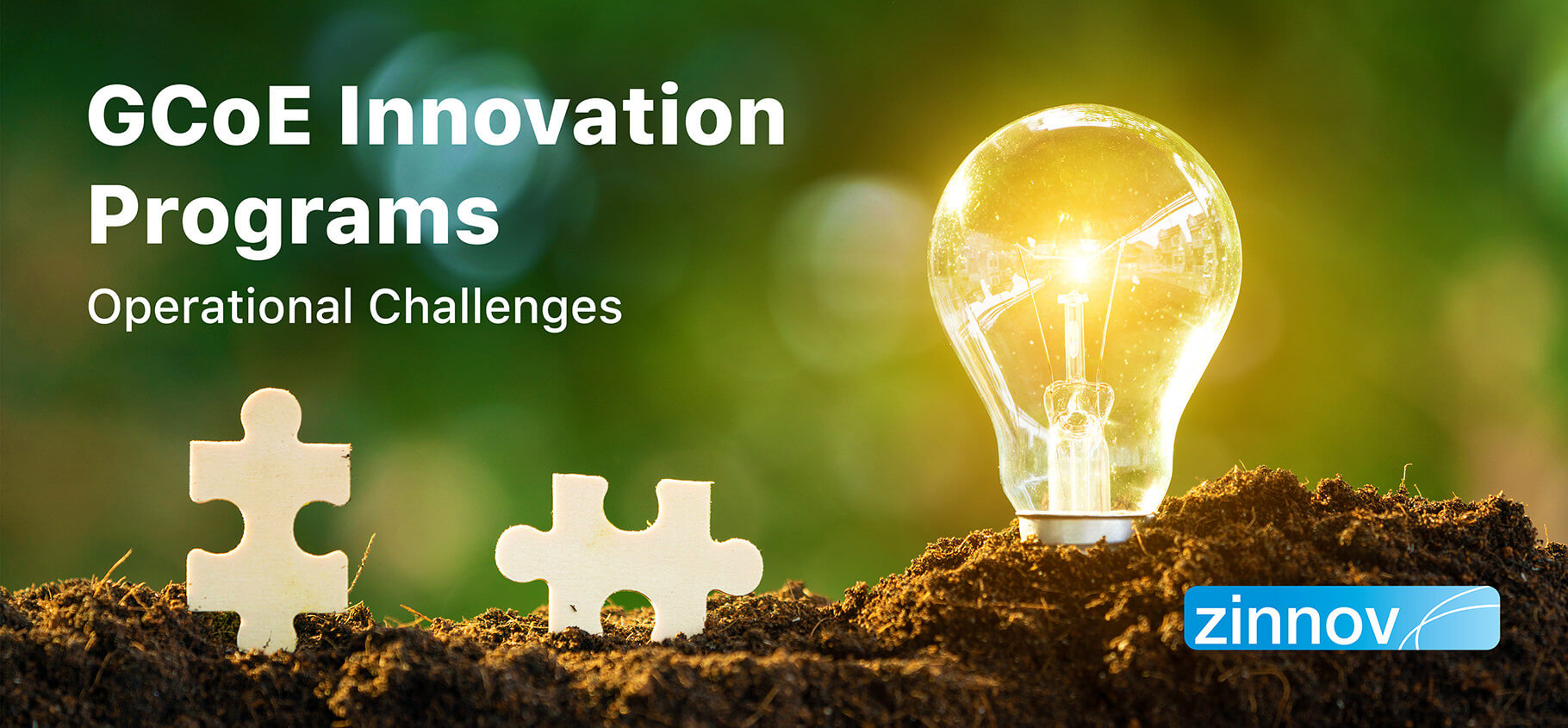|
|
Part II of the G.A.P. point of view on GCoE Innovation Programs

In his seminal work, ‘Management: Tasks, Responsibilities, Practices,’ Peter Drucker famously quoted, “Managing innovation will increasingly become a challenge to management, and especially to top management, and a touchstone of its competence.”
In part 1 of this blog series, we discussed the challenges that result from or lead to a lack of involvement from global and local top management.
However, the innovation buck does not stop at the top layers of an organization. Many operational challenges are faced by innovation teams and those employed by the organization, the prime contributors to innovation as some would say.
In this part, we shall focus on those operational challenges faced by GCoEs driving innovation which are:
Challenge 1: Inability to integrate outcomes of innovation programs
Metrics certainly help measure outcomes of an innovation program, but cannot improve the outcomes. The responsibility of understanding the intricacies of an innovation program and improving it falls on the innovation team. Innovation teams face a challenge with this, primarily as they do not comprehend the possible outcomes from each type of innovation program.
For example, hackathons are excellent platforms to collate ideas from distinct sources at once, but not for exploring them further. This is a problem for an innovation lab. Similarly, product demos will usually contribute towards an incremental innovation for the product, but may not be a great source of disruptive ideas.
To truly create value, GCoEs must have programs that cover all their bases. The most innovative organizations have this understanding and use it to create an innovation pipeline.
A pipeline model allows the strength of each program to be leveraged to the maximum and streamlines the innovation process.
Challenge 2: Inability to obtain quick and dirty outcomes
Rapid prototyping is an area where most innovation programs fail. Hackathons have the potential, but the instances of solutions being deployed quickly are few and far between. Prototyping labs are another avenue, yet they tend to be utilized by a minor proportion of the engineering team.
An enterprise software GCoE developed a different approach for prototyping solutions. They created disruption pods, small, temporary teams to oversee rapid product development. With a product manager at the helm, each pod is given a period of two months to explore and prototype new solutions.
Despite being a fledgling initiative, it has yielded two additions to the product roadmap in a year. The limited timeline fast-tracks the languorous process of idea development greatly, and more importantly, does so without alienating the engineering team from the process.
Challenge 3: Inability to involve the employee base
Employees have always been the key factor behind the democratization of the innovation process. Insights gathered from the people working closest to the product have become sources of great value to organizations, making employee participation core to the success of innovation programs.
However, the involvement of employees has two roadblocks from a GCoE’s context. The first lies in balancing innovation with delivery. A very small proportion of employees step up and contribute to innovation. This group of ‘elites’ end up contributing repeatedly, creating a perception that innovation is solely their domain.
The second problem is a distrust of the innovation process. Employees get discouraged when their ideas do not get chosen or when they are not permitted to work on developing it further.
The idea portal is the most commonly used ideation mechanism, but it can also be key to gaining the trust of the employee base. GCoEs have developed features on the portal that allow employees to track the progress of their ideas. Some have even gamified the process of idea evaluation to invite greater participation. Defining the role of the idea owner and ensuring constant feedback through the portal are other ways of ensuring that trust, desire, and motivation remain sustained.
Challenge 4: Inability to motivate the employee base
The final challenge lies in providing the right incentives to motivate the employee base to innovate in the first place. Recognition is an effective measure to achieve this outcome, but most GCoEs fail to outline clear and robust processes for recognizing value from in-house innovation.
Monetary as well as non-monetary incentives can be very useful here. It is imperative, however, to understand what employees want to be recognized for, and which incentive would be the most fitting.
One engineering GCoE has developed a highly structured set of varied mechanisms to recognize innovation. Employees are eligible to receive up to INR 1,00,000/- when a patent gets filed or granted. Idea development can get sponsored by the heads of individual product units, as well as the site head. Employees are also recognized at global leadership levels during company off-sites and strategy meets.
Creating incentives to recognize ideas that did not make the cut is another way to boost motivation. Publishing the idea in internal journals or providing personal feedback helps encourage the employee base, and thereby improves their ability to take risks even when faced with the potential of failure. This aspect of recognizing failure is a key ingredient to being known as an innovative organization by employees as well as the larger industry.
Organizations need to be open to identifying these leadership and operational challenges to boosting innovation in GCoEs. Then, it’s a matter of addressing these challenges in the best possible way that is suitable for specific innovation teams and organizations. From our conversations with key industry stakeholders, we have seen that most GCoEs still find it difficult to deal with innovation. The innovation maturity in the GCoE ecosystem is very low, and the trend shows no signs of changing anytime soon. However, a concerted effort to learn from key players in the industry who have done well, a clear idea of what can be done, and a lot of patience will move the needle in the right direction.